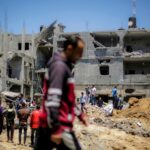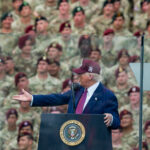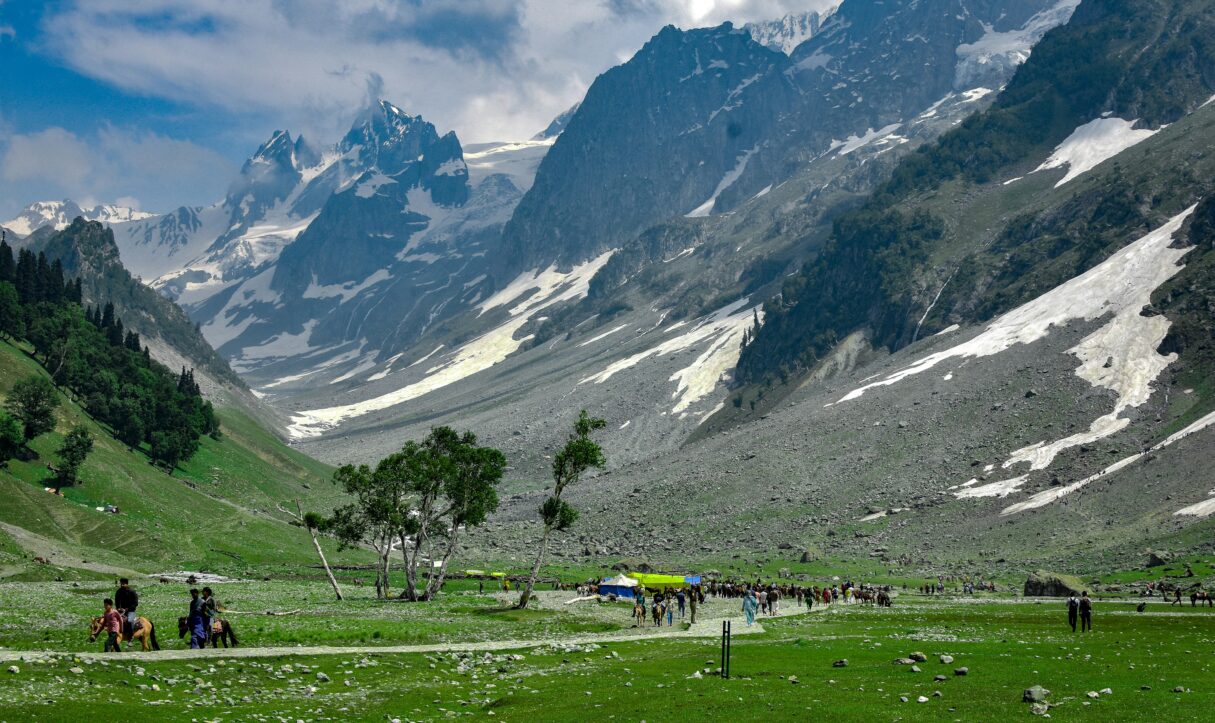In Dapaan: Tales from Kashmir’s Conflict, journalist and author Ipsita Chakravarty turns away from official scripts to listen instead to whispers, rumors, elegies, and satire that have shaped how Kashmiris live with conflict. Through oral memory, folklore, and grounded reportage, she reconstructs a Kashmir that resists state-imposed narratives and asserts the power of everyday storytelling as a means of political survival.
Dapaan offers a timely and vital exploration of the narratives that have shaped the everyday realities of Kashmiri communities through decades of turmoil. Chakravarty is an award-winning journalist with a decade of experience reporting on politics and conflict in Kashmir and North-East India. From the beginning, she anchors her work in the oral traditions of Kashmiri storytelling, employing the term dapaan, which means “it is said” in Kashmiri. This phrase interweaves myth, rumor, and memory to articulate intricate haalaat, the “conditions” that define life in the region.
In choosing dapaan as her guiding frame, Chakravarty gestures toward the multitude of voices and provisional truths that have circulated since 1989, when militancy, militarization, and political repression became entrenched features of life in Kashmir. The introduction recounts the story of a Srinagar businessman who buried his cherished radio-play cassettes alongside tapes of Pakistani pop music. “Haalaat kharaab hua,” he said. This act, blending grief and adaptation, encapsulates a recurring theme of her book: how ordinary Kashmiris navigate zulm (oppression), possession, loss, and the spectral remains of violence etched onto land and memory. The result is a necessary contribution to Kashmir studies, offering a textured account that foregrounds the perspectives of those most affected — and their quiet defiance in the face of geopolitical upheaval.
The businessman’s recollection of the Kashmiri radio play Myean Jigraki Daade Wath (“Let My Heart’s Ache Lift”) vanished from public life along with the pop songs of Pakistan in the early 1990s. The phrase “Haalaat kharaab hua” (“the situation worsened”), repeated and unadorned, becomes a refrain that signifies more than political instability. It marks a shift in atmosphere, one that reconfigures objects, narratives, and identities. Chakravarty traces the word haalaat from its Arabic origins into the Kashmiri lexicon, showing how its semantic weight deepened under conflict. Through dapaan, she grants these accounts a shared cultural legitimacy, connecting personal testimony with a collective archive of endurance.
In three chapters — “Zulm,” “Crackdown Paether,” and “You May Be Turned Into a Cat” — Chakravarty examines the subversive roles of humor, folk theater, and ridicule as expressions of resistance shaped under regimes of control.
In “Zulm,” she investigates the layered history and lived experience of oppression, spanning the Mughal and Dogra periods and extending into the present, marked by curfews, checkpoints, and arbitrary detentions. Through family accounts, she recalls how photographs and recordings of Pakistani songs were once buried in backyards to avoid suspicion. These stories reveal how memories and attachments were concealed to survive.
In “Crackdown Paether,” she turns to the folk theatre tradition of bhand paether, in which jesters and villagers stage satirical performances before chinar trees. Kings and soldiers are mocked in these enactments, as communities transform fear into laughter. This performative defiance provides momentary reprieve and solidarity. Chakravarty reflects on whispered riddles and warnings passed through alleyways and homes.
Living through a crackdown, with military cordons marking out areas, was likened to being in a panopticon and Dante’s circles of hell. In this environment, even folk theater adapted. The Wathora bhands, for instance, incorporated the Gun Kak joke into their plays, hoping that the government officials in the audience, particularly those from Delhi who didn’t understand much Kashmiri, would miss the subversive humor.
The pervasive presence of armed forces led to the coinage of Gun Saebs (gentlemen with guns), and inquiries about local militants were politely phrased as asking if “Gun Saeb was keeping well”. Chakravarty portrays how the fear and omnipresent surveillance transformed public and private communication, making ordinary expressions fraught with potential danger.
In the chapters “Raantas,” “The Steel Daen,” “The Braid Choppers,” and “Ghosts in the Ground,” Chakravarty turns to the specters that linger in Kashmiri life, both as metaphors and lived anxiety. In “Raantas,” she traces waves of panic sparked by tales of a ghostly woman seen near army convoys. These stories, told in hushed tones, reflect fears that resist rational explanation yet feel viscerally true.
These developments appear as progress but operate as instruments of possession. “The Braid Choppers” recounts a spate of incidents involving women whose braids were mysteriously cut. This chapter captures the fear of unseen violators and a community’s inability to defend its own. In “Ghosts in the Ground,” Chakravarty closes with a somber reflection on unmarked graves and the slow accumulation of grief. These sites, largely unnamed, speak to mourning without closure, where the past remains neither buried nor resolved.
She reads graveyards, cinemas, border crossings, and deserted orchards as sites shaped by violence and remembered through loss.
Chakravarty traces a historical lineage of surveillance, noting that although the spies of the Dogra king might have been decommissioned after 1947, the continuous internal insurrections prompted the government to vigilantly watch for signs of disaffection, with then prime minister of Jammu and Kashmir, Bakshi Ghulam Muhammad, even consolidating an army of vigilantes to patrol streets at night. The fate of these “cats” varied: some who temporarily cracked under interrogation would later joke about not exposing others during crackdowns. Still, militants often summarily executed “cats,” even those who succumbed to torture, viewing it as a reasonable consequence given their own willingness to die for the tehreek, or movement.
There is a harrowing account of AB, a young militant forced to become a “cat” through brutal torture, including electric shocks applied to his fingernails and toenails, a pain so excruciating it made him remember “drinking [his] mother’s milk.” AB’s forced role involved being driven around, identifying militants and weapons, and facing beatings if no discoveries were made. His narrative culminates in an act of profound human defiance, when an armed faction commander’s smile prevented AB from betraying him, despite the personal risk.
Chakravarty explores the rituals of mourning and how grief becomes entangled with political expression. She describes militant funerals where songs typically sung at weddings are repurposed as laments. These ceremonies, filled with both reverence and defiance, mirror how the memory of the late militant leader Burhan Wani circulates through ballads and social media, fostering a form of radicalization that draws heavily on visual and sonic imagery. In “Melancholia,” she turns to the quieter registers of sorrow: wilting gardens, melodies of exile, and a shared despondency that binds people together even as it deepens their solitude.
Chakravarty traces the contours of emotional life across Kashmir’s physical landscape. She reads graveyards, cinemas, border crossings, and deserted orchards as sites shaped by violence and remembered through loss. These become what she terms “blood maps,” spaces where personal and collective memory intersect. In “Firdous Cinema,” she recalls a once-bustling film theatre converted into a military barracks. She dwells on the unpredictable electricity cuts that descend like visitations, shifting the mood of entire neighborhoods.
Chakravarty concludes with the aftermath of the 2019 revocation of Article 370 and the subsequent communications blackout. She writes of how the haalaat have become silent themselves, closing down the public realm and leaving Kashmiris caught in a liminal space between remembrance and forgetting.
Chakravarty’s grounding in journalism is evident in her immersive approach to interviewing, her close attention to detail, and her insistence on aligning recollection with verification across multiple sources. She chooses not to rely on voices of influence, instead bringing forward the words of merchants, folk performers, schoolchildren, poets, and grieving mothers. This method resists the state’s dominant narratives of security and insurgency, shifting the focus to how the conflict permeates daily life. By shaping her work around dapaan, the Kashmiri expression for shared storytelling — “Stories are a way of knowing the world,” she writes — the author creates a structure where myth, archive, and memory are inseparable.
Her engagement with folkloric forms such as bhand paether, lament songs, and ghost stories shows the persistence of public life under pressure. Humor during oppression is not an escape but a form of encoded resistance. Ghost stories function as records of collective experience. Wedding songs sung at funerals are not mournful coincidences but deliberate political gestures. Chakravarty gives these expressions their own ground, refusing to filter them through a bureaucratic lens. Her position is clear as a view that challenges the narrator’s conventional authority.
Yet, she maintains narrative coherence by threading these oral accounts with historical milestones: the 1947 Partition, the Kashmiri insurgency of 1989, and the rise of the National Conference party. Her position as an outsider is softened by a tone of respect and restraint. She does not claim comprehensive understanding and presents dapaan as a method that accepts its own incompleteness. The result is a textured account that draws readers into a process of interpretation rather than offering final conclusions.
Dapaan emerges at a pivotal moment in Kashmir’s history. Since 1947, the region has witnessed three wars between India and Pakistan, as well as a near-war this year. It has endured a protracted insurgency that began in 1989 and experienced major political upheaval, most notably the revocation of Article 370 in August 2019. Chakravarty places her narrative against these defining events, tracing how they are remembered and retold through local haalaat stories. She recalls the salt shortages during Partition, the military sieges of 1989, and the communications shutdown of 2019, mapping how each episode carries forward the weight of the previous one while marking new ruptures.
Some historians have described Kashmir’s history as an allegory of surreal tragedy, shaped by geopolitical rivalries and sustained by cultural endurance and individual suffering. Dapaan contributes to this discourse by shifting attention toward vernacular sources: the rumor networks that circulate through whispers, the layered wit of bhand performers, and the silent presence of graves left unmarked. Through this lens, Chakravarty challenges imposed narratives — whether from Indian state media, which frames Kashmir as a security concern, or from Pakistan’s political framing, which casts the region as the site of religious struggle. Instead, she presents a landscape where myth and memory merge, and where the lives of ordinary people assume political significance.
Her integration of mythic structures with investigative journalism aligns her with scholars who advocate for detailed readings of conflict, and writers who center Kashmiri perspectives rather than merely offer projection from the outside. Chakravarty’s work highlights the shortcomings of state-controlled records and underscores the value of oral testimony, resonating with the view of memory as a guide rather than a static record. In this approach, Dapaan finds kinship with important works in Afghan and Middle Eastern studies that emphasize local voices when interpreting regional unrest.
Chakravarty’s most significant contribution lies in her ability to bring the lives of ordinary Kashmiris to the forefront. By giving space to these voices, she counters the dominant image of the conflict as solely defined by insurgency or state response. The emotional range found in these individual accounts offers readers a more humane entry into the region’s political context. The structure of the book is organized around the idea of dapaan, which provides both cultural grounding and analytical precision.
For my part, reading Dapaan altered my way of listening. I began to hear the faint echoes of stifled voices and to sense the layered weight of place. Chakravarty’s depiction of burials, photographs, tapes, memories, stories, and myths seemed to symbolize the hidden archives Kashmiris carry within themselves.
As someone with knowledge of Kashmir’s daily life, I was struck by the openness of the accounts she gathered. A mother’s fear, barely audible in a whisper, as well as a teenager’s laughter as he defied a curfew, both stayed with me. The idea of dapaan — it is said — echoed long after I finished the book. Dapaan altered my perception of how conflict shapes culture, and how culture, in turn, resists disappearance. Stories are a way of knowing the world and these stories are my stories and will remain with me as I think about zones of violence and the need to listen beyond headlines. There are people, after all, at the heart of Kashmir’s seemingly unending crisis.














